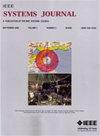网络辅助全双工无小区大规模MIMO系统中工业URLLC的AP工作模式选择和块长度优化
IF 4.4
3区 计算机科学
Q1 COMPUTER SCIENCE, INFORMATION SYSTEMS
引用次数: 0
摘要
网络辅助全双工(NAFD)无单元大规模多输入多输出(MIMO)系统通过采用半双工接入点(ap)同时为同一频段的上行链路(UL)和下行链路(DL)用户提供服务,实际上实现了FD传输,可以减少延迟并提高可靠性,因为无需自干扰消除,并且提供了宏分集,从而有助于工业超可靠的低延迟通信应用。在本文中,我们考虑了一个使用有限块长度码字的NAFD无单元系统的工业自动化监控场景,并分析了UL和DL信号、端到端(E2E)延迟和端到端解码错误概率(DEP)。然后,在端到端延迟约束下,通过联合设计AP工作模式、UL和DL块长度,构造了一个最小化所有执行器中最大端到端DEP的优化问题。我们提出了一种低复杂度的估计分布算法-差分进化(EDA-DE)方法来获得近似最优解,其中采用块坐标下降法将该问题分为两部分。第一种AP工作模式选择由EDA解决,第二种UL和DL块长度由DE设计。仿真结果表明,EDA-DE方法性能接近穷举搜索,且计算复杂度较低。本文章由计算机程序翻译,如有差异,请以英文原文为准。
AP Working Mode Selection and Blocklength Optimization for Industrial URLLC in Network-Assisted Full-Duplex Cell-Free Massive MIMO Systems
Network-assisted full-duplex (NAFD) cell-free massive multiple-input–multiple-output (MIMO) systems, which virtually achieve FD transmission by employing half-duplex access points (APs) to simultaneously serve uplink (UL) and downlink (DL) users on the same frequency bands, can decrease latency and enhance reliability since self-interference cancellation is unnecessary and macrodiversity is provided, thus helping industrial ultrareliable low-latency communication applications. In this article, we consider a monitoring scenario of industrial automation in NAFD cell-free systems using finite blocklength codewords and analyze UL and DL signals, end-to-end (E2E) delay, and E2E decoding error probability (DEP). Then, an optimization problem is formulated to minimize the maximum E2E DEP among all actuators by jointly designing AP working mode, UL and DL blocklengths under the E2E delay constraint. We propose the estimation of distribution algorithm-differential evolution (EDA-DE) method with low complexity to obtain a near-optimal solution, where the block coordinate descent is used to divide this problem into two parts. The first AP working mode selection is solved by EDA, and the second UL and DL blocklengths are designed by DE. Simulation results indicate that the performance of our proposed EDA-DE method is close to that of exhaustive search with lower computational complexity.
求助全文
通过发布文献求助,成功后即可免费获取论文全文。
去求助
来源期刊

IEEE Systems Journal
工程技术-电信学
CiteScore
9.80
自引率
6.80%
发文量
572
审稿时长
4.9 months
期刊介绍:
This publication provides a systems-level, focused forum for application-oriented manuscripts that address complex systems and system-of-systems of national and global significance. It intends to encourage and facilitate cooperation and interaction among IEEE Societies with systems-level and systems engineering interest, and to attract non-IEEE contributors and readers from around the globe. Our IEEE Systems Council job is to address issues in new ways that are not solvable in the domains of the existing IEEE or other societies or global organizations. These problems do not fit within traditional hierarchical boundaries. For example, disaster response such as that triggered by Hurricane Katrina, tsunamis, or current volcanic eruptions is not solvable by pure engineering solutions. We need to think about changing and enlarging the paradigm to include systems issues.
 求助内容:
求助内容: 应助结果提醒方式:
应助结果提醒方式:


